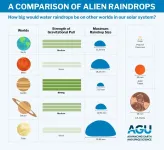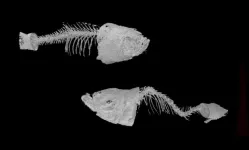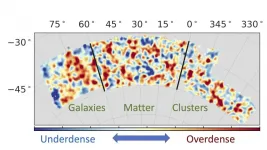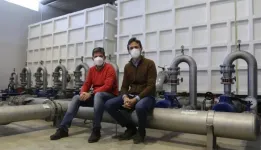(Press-News.org) WASHINGTON--Raindrops on other planets and moons are close to the size of raindrops on Earth despite having different chemical compositions and falling through vastly different atmospheres, a new study finds. The results suggest raindrops falling from clouds are surprisingly similar across a wide range of planetary conditions, which could help scientists better understand the climates and precipitation cycles of other worlds, according to the researchers.
Raindrops on Earth are made of water, but other worlds in our solar system have precipitation made of more unusual stuff. On Venus, it rains sulfuric acid; on Jupiter, it rains helium and mushy ammonia hailstones. On Mars, it snows carbon dioxide, or dry ice. On Saturn's moon Titan, it rains methane, or liquified natural gas. And on Neptune, scientists suspect it rains pure carbon in the form of diamonds. It could even rain iron or quartz on some planets if the conditions were right.
A new study looking at the physics of how liquid droplets behave while they fall from clouds finds only droplets in clouds within a limited size range - between about a tenth of a millimeter to several millimeters in radius - can reach the surface of rocky planets as rain. This is a fairly narrow size range, given that raindrops increase about a million times in volume during their formation inside a cloud.
The results also show the maximum size of liquid droplets that fall as rain is similar across varying planetary conditions. Different types of liquid droplets would max out around half to six times the size of water rain on Earth, depending on the strength of the planet's gravitational pull (the stronger the gravitational pull, the smaller the raindrop). Find an infographic comparing the size of raindrops on Earth, Mars, Jupiter, Saturn and Titan here.
"There's a fairly small range of stable sizes that these different composition raindrops can have; they're all fundamentally limited to be around the same maximum size," said Kaitlyn Loftus, a planetary scientist at Harvard University and lead author of the new study in AGU's Journal of Geophysical Research: Planets, which publishes research on the formation and evolution of the planets, moons and objects of our solar system and beyond.
Rain on other worlds
In the new study, Loftus and colleague Robin Wordsworth used math and physics principles to model how liquid water droplets fall through planetary atmospheres. They wanted to determine the possible size ranges for droplets falling from a cloud to a planetary surface. Raindrops that are too big break up into smaller ones, while raindrops that are too small evaporate before they hit the ground.
They first determined the possible size ranges for water raindrops on rocky planets like Earth and Mars, given atmospheric conditions like temperature, air pressure, relative humidity, distance from the cloud to the ground and the strength of the planet's gravitational pull.
They found raindrops with a radius smaller than about a tenth of a millimeter evaporate before they ever reach the surface, and raindrops larger than several millimeters in radius break up into smaller droplets as they fall.
They then looked at how water raindrops would fall on much bigger planets like Jupiter and Saturn that have vastly different atmospheres. Comparing modern Earth, ancient Mars and these bigger planets, they found raindrops move water through air similarly, even though what constitutes "air" varies widely among the planets.
Even when different liquids make up raindrops, these alien raindrops are not so different from familiar water raindrops, according to the researchers' calculations. For example, the largest methane raindrops on Titan would be about twice the size of water rain on Earth. Loftus isn't certain why the maximum raindrop size is so uniform, but she suspects it may be due to how a droplet's surface tension relates to its density.
The findings will help scientists better simulate the conditions on other planets, as precipitation is a key component in a planet's climate and nutrient cycles, Loftus said. Modeling what precipitation might look like on a distant world could also help researchers interpret observations of exoplanetary atmospheres made by space telescopes, said Tristan Guillot, a planetary scientist at the Observatoire de la Côte d'Azur in Nice, France, who was not connected to the new study.
"Now with instruments like [the James Webb Space Telescope], which hopefully will soon be launched, we will have the capability to detect really fine spectra of exoplanetary atmospheres, including ones that are quite cooler than ones we're usually able to characterize, in which clouds and rain will occur," Guillot said. "So these kinds of tools as they are developed will be very useful and important to interpret those spectra."
INFORMATION:
AGU (http://www.agu.org) supports 130,000 enthusiasts to experts worldwide in Earth and space sciences. Through broad and inclusive partnerships, we advance discovery and solution science that accelerate knowledge and create solutions that are ethical, unbiased and respectful of communities and their values. Our programs include serving as a scholarly publisher, convening virtual and in-person events and providing career support. We live our values in everything we do, such as our net zero energy renovated building in Washington, D.C. and our Ethics and Equity Center, which fosters a diverse and inclusive geoscience community to ensure responsible conduct.
Notes for Journalists
This research study will be freely available for 30 days. Download a PDF copy of the paper here. Neither the paper nor this press release is under embargo.
Download multimedia accompanying this release from AGU's newsroom.
Paper title: "The physics of falling raindrops in diverse planetary atmospheres"
Authors:
Kaitlyn Loftus, Harvard University, Cambridge, Massachusetts
Robin D. Wordsworth, Harvard University, Cambridge, Massachusetts END
As part of an international collaboration, researchers from ELTE Eötvös Loránd University developed a new animal model to study a rare genetic disease that can lead to blindness at the age of 40-50. The new model could open up new perspectives in our understanding of this metabolic disease and will also help to identify new potential drug candidates, according to the recent study published in Frontiers in Cell and Developmental Biology.
Pseudoxanthoma elasticum (PXE) is a rare genetic disease with symptoms that usually manifest in adolescence or in early adulthood. The symptoms are caused by the appearance of hydroxyapatite crystal deposits in the subcutaneous connective tissue and retina ...
The universe is expanding at an ever-increasing rate, and while no one is sure why, researchers with the Dark Energy Survey (DES) at least had a strategy for figuring it out: They would combine measurements of the distribution of matter, galaxies and galaxy clusters to better understand what's going on.
Reaching that goal turned out to be pretty tricky, but now a team led by researchers at the Department of Energy's SLAC National Accelerator Laboratory, Stanford University and the University of Arizona have come up with a solution. Their analysis, published April 6 in Physical Review ...
Nursing mothers who receive a COVID-19 vaccine may pass protective antibodies to their babies through breast milk for at least 80 days following vaccination, suggests new research from Washington University School of Medicine in St. Louis.
"Our study showed a huge boost in antibodies against the COVID-19 virus in breast milk starting two weeks after the first shot, and this response was sustained for the course of our study, which was almost three months long," said first author Jeannie Kelly, MD, assistant professor of obstetrics and gynecology. "The antibodies levels were still high at the end of our study, so the protection likely extends even longer."
Based ...
Cells from individuals with Major Depressive Disorder (MDD) were found to have higher than expected rates of methylation at specific sites on their DNA, when compared to cells from healthy individuals without MDD, according to a study by a multidisciplinary team of UC San Francisco scientists, in collaboration with others. Methylation is a process by which DNA is chemically modified at specific sites, resulting in changes in the expression of certain genes. Methylation of particular sets of genes, called "DNA methylation clocks," typically change in predictable ways as people ...
During the early phase of the pandemic, approximately 40% of the COVID-19 literature was shared as preprints - freely available manuscripts that are shared prior to peer-review. In a new study publishing in the open access journal PLOS Biology, researchers led by Dr Jonathon Coates (Queen Mary University of London), Dr Nicholas Fraser (Leibniz Information Centre for Economics, Germany) and Dr Liam Brierley (University of Liverpool) explore the crucial role of preprint servers in hosting COVID-19 related science and how these preprints have been used to disseminate knowledge of COVID-19, leading to cultural shifts in journalistic and policy practices.
There has been a rapid and incredible scientific response to the COVID-19 pandemic, with research ...
Innovation and advances in technology have facilitated agricultural activity in recent years, as traditional irrigation techniques have been supplanted by pressure-basedones, improving water efficiency but increasing energy dependence. This drives up the Agriculture sector's energy costs, some of the highest in the European Union.
With the aim of increasing the energy efficiency of irrigation, researchers at the Hydraulics and Irrigation Group with the María de Maeztu Unit of Excellence,at the Department of Agronomy of the University of Cordoba (DAUCO), Juan Antonio Rodríguez Díaz and Jorge García Morillo, have field-tested a low-cost technology that takes advantage of the excess pressure on the grid to generate energy. This ...
It is difficult to imagine our daily life without lithium-ion batteries. They dominate the small format battery market for portable electronic devices, and are also commonly used in electric vehicles. At the same time, lithium-ion batteries have a number of serious issues, including: a potential fire hazard and performance loss at cold temperatures; as well as a considerable environmental impact of spent battery disposal.
According to the leader of the team of researchers, Professor in the Department of Electrochemistry at St Petersburg University END ...
Ambient air pollution is a global public health crisis, causing more than 4.9 million premature deaths per year around the world. In Africa, it has surpassed AIDS as the leading cause of premature death. According to one study, air pollution--specifically, fine particulate matter (PM2.5)--may cause at least as many as 780,000 premature deaths annually in Africa and worsen a significant number of diseases, including asthma, lung cancer, and chronic obstructive pulmonary disease.
Kinshasa, capital of the Democratic Republic of the Congo, and Brazzaville, capital of the Republic of Congo, are both large metropolises. However, neither Kinshasa (population 14. 3 million) nor Brazzaville (population 2.4 million) have had comprehensive air quality monitoring programs. ...
Scientists at UCL have used artificial intelligence (AI) to identify three new multiple sclerosis (MS) subtypes. Researchers say the groundbreaking findings will help identify those people more likely to have disease progression and help target treatments more effectively.
MS affects over 2.8 million people globally and 130,000 in the UK, and is classified into four* 'courses' (groups), which are defined as either relapsing or progressive. Patients are categorised by a mixture of clinical observations, assisted by MRI brain images, and patients' symptoms. These observations guide the timing and choice of treatment.
For this study, published in Nature Communications, researchers wanted to find out if there were any - as yet unidentified - patterns ...
HOUSTON - (April 6, 2021) - Runoff from Houston's 2016 Tax Day flood and 2017's Hurricane Harvey flood carried human waste onto coral reefs more than 100 miles offshore in the Flower Garden Banks National Marine Sanctuary, according to a Rice University study.
"We were pretty shocked," said marine biologist Adrienne Correa, co-author of the study in Frontiers in Marine Science. "One thing we always thought the Flower Garden Banks were safe from was terrestrial runoff and nutrient pollution. It's a jolt to realize that in these extreme events, it's not just the salt marsh or the seagrass that we need to worry about. Offshore ecosystems can be affected too."
The Flower Garden Banks sit atop several salt domes near the edge ...







